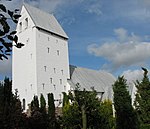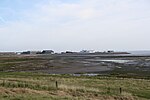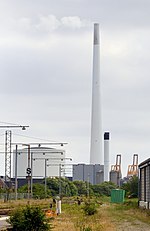Mandø

Mandø or Manø (Danish pronunciation: [mænøˀ]) is one of the Danish Wadden Sea islands off the southwest coast of Jutland, Denmark in the Wadden Sea, part of the North Sea. The island covers an area of 7.63 square kilometres (2.95 square miles) and had between 27-31 inhabitants in January 2022. The island is part of Esbjerg Municipality and is situated approximately 12 kilometres (7 miles) southwest of the ancient town of Ribe. Mandø is barely accessible by road at high tide over an unpaved surface level causeway of about four kilometers in length that connects the island to the mainland. Low tide transit is possible. Extensive mudflats and tidal marshes encircle the island and provide breeding areas to multitudes of birds and other organisms. In the past centuries several large earthen dikes have been constructed around the perimeter of the island, although substantially set back from the shoreline. This artifice has allowed conventional farming in the form of grain growing and sheep grazing. Mandø is technically a hallig, although it is far from the ten German islands commonly described by that term. The name was formerly often spelled Manø.
Excerpt from the Wikipedia article Mandø (License: CC BY-SA 3.0, Authors, Images).Mandø
Vestervej, Esbjerg Municipality
Geographical coordinates (GPS) Address Nearby Places Show on map
Geographical coordinates (GPS)
| Latitude | Longitude |
|---|---|
| N 55.280555555556 ° | E 8.5527777777778 ° |
Address
Vestervej
Esbjerg Municipality
Region of Southern Denmark, Denmark
Open on Google Maps









